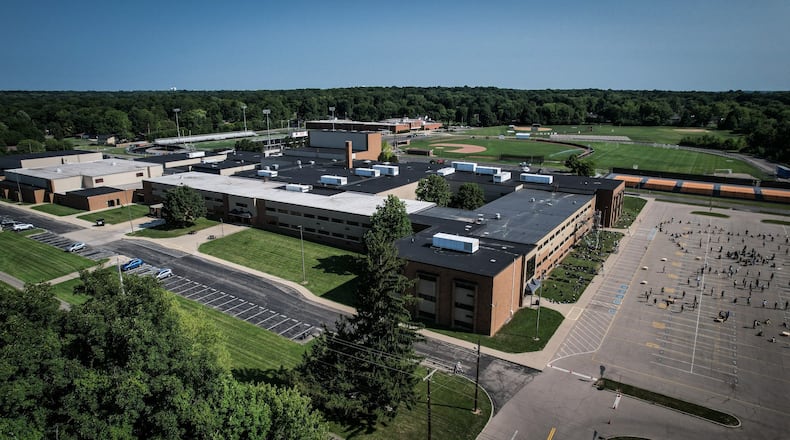About $260 million of the $265 million total would go toward constructing a new high school at an 89-acre property on the southeast corner of South Alpha Bellbrook Road and Indian Ripple Road. The site is in Beavercreek Twp., just south of the Russ Research Center property, a half-mile west of The Narrows Reserve on the Little Miami River.
While construction of a new high school would be the headline of the project if voters approve, that move would cause a domino effect of changes across the district.
The current high school would then be renovated into a middle school for sixth, seventh, and eighth grade students. Ferguson Hall would be used for alternative programming, such as working with the Greene County Career Center. Coy Middle School and Ankeney Middle School would both be converted to elementary schools.
The oldest elementary school, Main Elementary, would be renovated into central offices for the district, and the district’s current offices off of Kemp Road would be redesigned into a centralized preschool.
This proposed high school would put grades 9 through 12 under one roof. Currently, Beavercreek high school freshmen have most of their education at Ferguson Hall.
“This would be putting all of nine through 12 in the same facility, which would be a plus for our district,” said Beavercreek schools Superintendent Paul Otten. “Our families would like that. I don’t think they love the separate ninth grade building, because we have kids that travel between the two buildings every period for classes.”
In addition to the school building itself, the new high school campus would have a 1,200-seat theater, and a roughly 5,500-square foot football stadium. Plans for the new high school also include a 1000-seat soccer stadium, a practice field for marching band, and 1,400 parking spaces.
Credit: Jim Noelker
Credit: Jim Noelker
Beavercreek’s preschool is expanding rapidly, Otten said, and the transition of the Kemp location from offices to preschool classrooms is already underway. Beavercreek’s administrative functions will be in a rented office space for the time being.
“We will have four preschool classrooms at Parkwood Elementary School, and then we’re filled in our preschool center which happens to be attached to our central office, so we figured it would be best to get all all our kids under one roof for preschool,” he said.
Beavercreek is seeing rapidly increasing enrollment at the elementary and middle school levels. This, and the continuous residential development in and around the city, prompted the district to develop this master facilities plan with the community back in the 2018-2019 school year.
“One of the pieces that was communicated was, if we’re going to build something, let’s build something that’s going to stand the test of time, meaning, let’s not build something that we’re back here in 12 years talking about another building project,” Otten said.
The new construction would address anticipated growth over the next 25 to 35 years, Otten said, as housing subdivisions continue to be built in and around Beavercreek.
“If you drive around Beavercreek, you’re seeing ... areas that have sidewalks, they have streets, they have no houses yet and they’re digging holes to put basements in right now.”
Similar to other local districts, Beavercreek is working with the Ohio Facilities Construction Commission to fund its building improvements. However, Beavercreek has some differences in its model.
Beavercreek is considered an Expedited Local Partnership Program (ELPP) district with the Ohio Facilities Construction Commission. The commission decides which school districts in a given year will get state money for facilities that year. Beavercreek’s number has not yet come up.
If the bond is passed and the construction is completed, when Beavercreek’s number is drawn, the state will credit the district for a portion of the money spent on the project, currently estimated between $20 million and $25 million.
At that point, school leadership will have to determine whether that money goes towards improving facilities, or it could be used to pay off the bond early, Otten said.
“At some point, some treasurer and superintendent is going to get a check from the state for this project,” he said. “We are working with OFCC to get credit for that. So trying to do everything we can so that our community isn’t the sole partner in this project, that really the state can be a partner as well. It just may be that it’s 10 years from now.”
Should the bond issue pass in November, design for the high school would likely start in January, Otten said. Between design and construction, the new high school would likely be completed in the 2029-2030 school year, and students who this past spring finished third grade would start as freshmen in the new school.
Credit: Jim Noelker
Credit: Jim Noelker
About the Author




